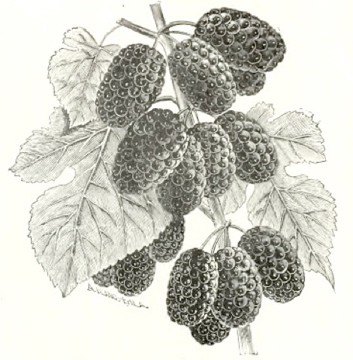 HICKS EVERBEARING
HICKS EVERBEARING
On the eve of the Civil War the great New York horticulturist and nursery man, William Prince, informed the fruit lovers of America that they could choose among three everbearing mulberries—three that dropped fruit from April through July. There was the White ever-bearing, a descendent of the White Italian, Downing’s Everbearing, a seedling of the white Chinese imported into the western hemisphere to feed silk worms. And there was the finest of the three, “Herbemont’s or Hicks’ Every-bearing. Prince indicated that this was “a much hardier variety” and superior to the Downing in “size, quality of its fruit, which is produced over a considerably larger period of time.” The crops of the Hicks were prolific, and extending from the end of April into the middle of July. He noted that the variety had distinctive red wood. [William R. Prince, “Ever-bearing Mulberries,” Horticulturist and Journal of Rural Art (April 1860), 157.]
In the late 1820s Nicholas Herbemont, the French-born pomologist and French instructor at the College of South Carolina in Columbia, SC, promoted viticulture as an alternative to southern cotton farming. He had successfully grown hybrid grapes in the Carolina midlands and became convinced that the state could become America’s first wine region. The agricultural press of that period was much taken with the idea of silk manufacture as a home craft occupying the slack weeks of midwinter on the farm. Silk worms might feed on the leaves of white mulberry and spin gold. Herbemont, too, fell under the spell of this idea, believing that it might occupy those times when a viticulturist did not tend the vines. He secured white mulberry and transplanted native red mulberry trees to his block sized garden on Gervais street in Carolina’s capital city. He crossed them, producing a hybrid with the vigor and resistance of the Native berry and the taste and juiciness of the white. He realized immediately its value as hog and chicken feed.
P. J. Berkmans of the famous Fruitlands Nursery in August observed about Hicks: “sweet fruit and insipid, but produced in immense quantities during four months, excellent for poultry; a fine rapid growing shade tree. [1872 Catalog, p. 28]. The Hale’s Southern Fruit Catalog of 1897 added that it “bears young; should be grown by every farmer who keeps swine or poultry; this variety being of special value for this purpose” (p. 12). Munson of Denison Texas went so far as to call it “the best of all trees for the fowl-yard” (Catalog of 1890, p. 11). In 1892, a widely syndicated newspaper piece on “The Hog Pasture” described the ideal set up for a Hicks Mulberry orchards: “Plant Hicks’ ever-bearing mulberry trees thirty feet apart both ways—forty-eight trees to the acre. . . . The Hicks mulberry is a rapid grower and early and prolific bearer, and seems to be as hardy as the wild mulberry. Begins to ripen its fruit here first of May, and continues four solid months. The fruit is more excellent for hogs and poultry and far better for man than the wild variety” (“The Hog Pasture,” Bossier Banner, April 28, 1892, 4).
Image: Catalog, Willow Lake Nursery 1888, Marshallville GA
David S. Shields